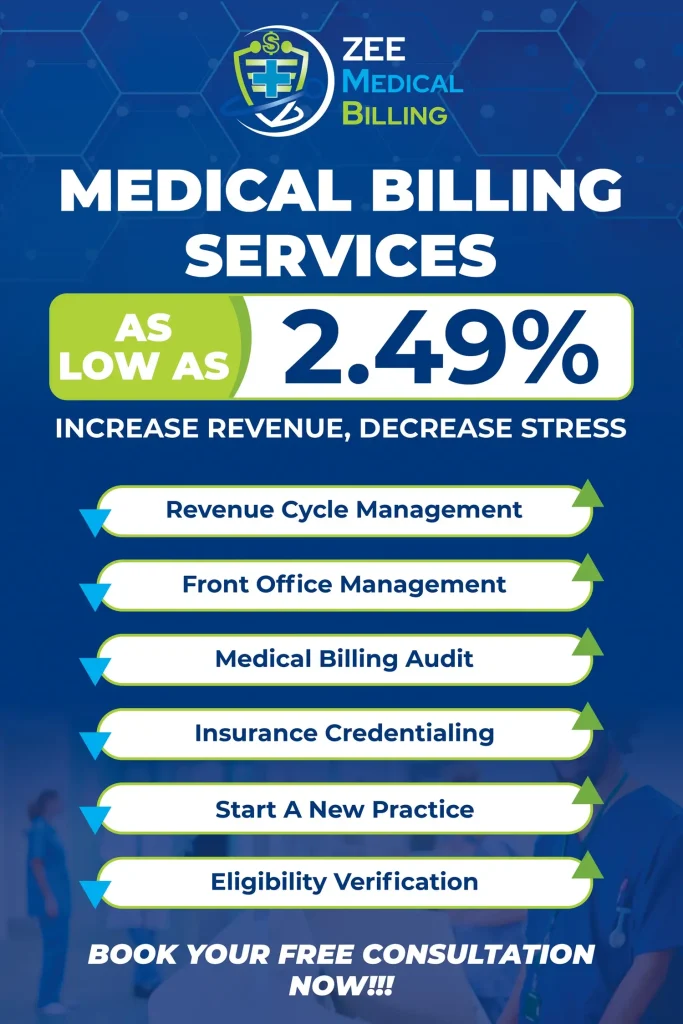Knowing how and when to use Modifier 50 is important for correct medical billing. This is especially true for bilateral procedures. Providers often apply this modifier to CPT codes when they perform a method on both sides of the body during the same session. Using Modifier 50 correctly ensures appropriate reimbursement and reduces claim denials.
What is Modifier 50?
Modifier 50 indicates that a bilateral procedure was performed. Instead of reporting the same CPT code two times, you use the 50 modifier. This indicates that the service was performed on both the left and right sides during a single visit.
Read More: An Easy Guide to Modifier 51 and When to Use It?
Modifier 50 Description:
Modifier 50 – Bilateral Procedure: Unless stated otherwise, use modifier 50 for bilateral procedures done in the same session. Add this modifier to the five-digit CPT code.
What Does Bilateral Mean in Medical Terms?
In medical coding, ‘bilateral’ means procedures done on both sides of the body. This includes both eyes, ears, arms, legs, and organs like the kidneys or lungs.
Bilateral Medical Definition:
The term bilateral means “on both sides.” For example, a bilateral salpingectomy refers to the removal of both fallopian tubes.
Understanding the bilateral meaning in medical terms enables coders to apply Modifier 50 accurately.
When to Use Modifier 50?
Modifier 50 should be used when:
- The exact surgical procedure is performed on both sides of the body.
- The CPT code description does not already include the word “bilateral.”
- The procedure is performed during the same operative session.
- Examples of Use Cases:
| CPT Code | Procedure Description | Bilateral Use | Correct Reporting |
| 58661 | Laparoscopy w/ removal of adnexa | Both ovaries removed | 58661-50 |
| 29806 | Shoulder arthroscopy | Both shoulders | 29806-50 |
| 58558 | Hysteroscopy | Single uterus | Do NOT use 50 |
If a CPT code already states “bilateral,” Modifier 50 should not be used, as it would be redundant.
How to Apply Modifier 50 in Billing?
Two standard billing formats exist depending on payer requirements:
- Single Line with Modifier 50
- Example: 29806-50, Quantity: 1
- Two Lines Without Modifier 50 (each with RT and LT modifiers)
- Line 1: 29806-RT, Qty: 1
- Line 2: 29806-LT, Qty: 1
Check payer-specific guidelines to determine the preferred reporting method. Medicare typically accepts the single-line approach with Modifier 50.
Understanding CPT Codes and Bilateral Procedures
CPT stands for Current Procedural Terminology, and it provides codes to describe medical, surgical, and diagnostic services.
CPT Code Examples:
- CPT code for bilateral salpingectomy: 58700 (When performed bilaterally, use 58700-50)
- CPT code for left shoulder arthroscopy: 29806-LT
If the same arthroscopy is performed on the right shoulder during the same session, use code 29806-50 (depending on payer rules).
Common Misconceptions About Modifier 50
- Modifier 50 is not a quantity indicator. Use it to indicate laterality, not the number of procedures.
- Please don’t use it with inherently bilateral CPT codes.
- Do not confuse Modifier 50 with modifiers RT (Right) and LT (Left). These are for unilateral services.
Read More: What Does Modifier 26 Mean in CPT Medical Coding?
Modifier 50 vs Other Bilateral Modifiers
| Modifier | Purpose | When to Use |
| 50 | Bilateral procedure | Same procedure on both sides, same session |
| LT | Left side | Unilateral procedures only |
| RT | Right side | Unilateral procedures only |
| 51 | Multiple procedures | More than one procedure in one session, not bilateral specifically |
Best Practices for Coders
- Review the CPT code description for “bilateral.”
- Always verify payer-specific policies.
- Use correct units and modifiers to avoid over- or under-billing.
- Never apply Modifier 50 where it’s not valid, such as for midline or single-organ procedures.
FAQs
1. What is the difference between Modifier 50 and reporting two separate CPT codes?
Modifier 50 simplifies billing when the same procedure occurs on both sides of the body. Instead of reporting two lines, one for each side, you report one line with Modifier 50. This shows that it is a bilateral procedure. Medicare and some private payers often require this approach.
2. Can all CPT codes be used with Modifier 50?
No, Modifier 50 should only be used with CPT codes for procedures that can be done on both sides of the body. Do not append Modifier 50 to codes that already specify “bilateral” in their description or are inherently bilateral.
3. How does Modifier 50 affect reimbursement?
Adjusters may modify reimbursement when using Modifier 50. Medicare often pays 150% of the allowed fee for a unilateral procedure. This means 100% for the first side and 50% for the second side when Modifier 50 is used correctly. Private-payer reimbursement policies may vary.
4. Should I use Modifier 50 for diagnostic procedures?
The diagnostic procedure can only occur bilaterally if both sides undergo testing in the same session. Check the CPT code description and payer rules before applying Modifier 50 to diagnostic services.
5. What are some common errors when using Modifier 50?
Errors include using Modifier 50 with midline organs, like the uterus. Do not apply it to codes that are already defined as bilateral. Additionally, assuming it indicates the number of times a procedure was performed is incorrect. Additionally, using Modifier 50 with codes that aren’t eligible for bilateral reporting can result in denials.
Conclusion
Modifier 50 plays a critical role in accurately coding bilateral procedures in medical billing, by knowing when and how to use it — and when not to — coders can avoid mistakes, lower claim rejections, and ensure fair payment. Always refer to the CPT code descriptions, consider the anatomy involved, and follow payer-specific rules to apply this modifier correctly.
For more insights into medical billing practices, visit Blog — your resource for clear, reliable healthcare billing information.
Need Expert Medical Billing Services?
Zee Medical Billing provides professional billing solutions tailored to healthcare providers across the nation. In addition to providing top-tier support from our main office, we proudly serve clients in 19 states: Illinois, Indiana, California, Kentucky, New York, Washington, Georgia, Alabama, South Carolina, Texas, Pennsylvania, Ohio, New Hampshire, Nevada, Massachusetts, Hawaii, Arizona, and Colorado. Whether you’re looking to streamline your revenue cycle or improve claims accuracy, you can reach out to us to learn more about how we can support your practice.









